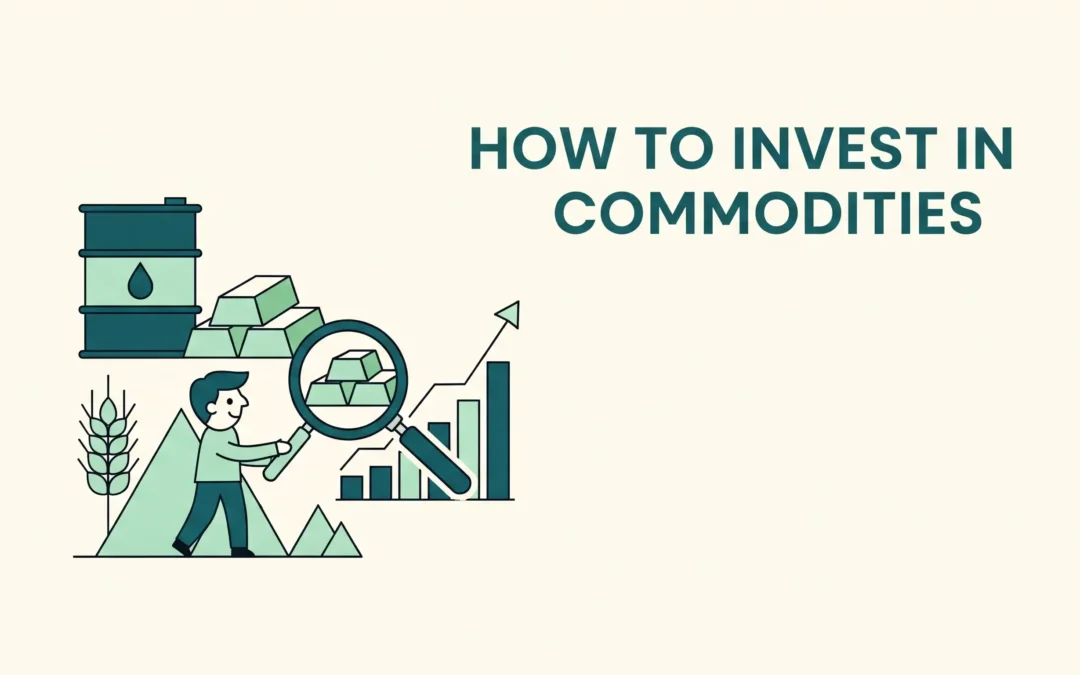Investing in commodities is not a new concept. People have been doing it for ages in the form of previous metals. They are not just investments but hold sentimental value as well. However, with advanced technology and rapid digitalization, you can hold them in various other forms. They are similar to their physical form with little change in terms of additional cost.
This article will help you understand how you invest in commodities, along with briefly explaining the pros and cons of each option.
Why Invest in Commodities?
Commodities shield against currency devaluation, act as a hedge against inflation, and frequently do well in uncertain markets. They are impacted by global supply and demand, unlike stocks.
Key Features:
- Protection from Inflation: Gold and oil typically hold their value or rise in response to inflation.
- Diversification: The price of commodities frequently fluctuates separately from that of stocks and bonds.
- High-risk, high-reward potential: Particularly with oil and silver, this makes the market volatile but rewarding
- Geopolitical Sensitivity: Trade restrictions, economic policies, and wars all affect prices.
How to Invest in Gold?
For centuries, gold has been used as a conventional store of value. Let us see how you can invest in them.
1. Investing in tangible gold
- Conventional method of investment.
- Entails charging, storage expenses, and theft risk.
- Superior to pure investment in terms of emotional value.
2. Digital Gold
- Purchase gold using services like PhonePe, Google Pay, or Paytm
- Supported by real, tangible gold that is kept in safe vaults.
- Investing as little as Rs. 1 is possible
- It provides flexibility
3. Mutual funds and gold exchange-traded funds
- Traded on the exchange similarly to stocks.
- Represent the cost of actual gold.
- You don’t have to be concerned about purity or storage.
- For example: Nippon India Gold ETF.
- Ideal for people without demat accounts.
4. SGBs, or sovereign gold bonds
- Issued on behalf of the government by the Reserve Bank of India.
- Get 2.5% yearly interest in addition to capital gains.
- No physical risk because it is held in demat form.
How to Invest in Silver?
Silver is a special asset class for portfolio diversification since it is both a precious metal and an industrial commodity. Let us see how you can invest in silver.
1. Physical Silver
Purchasing silver jewellery, coins, or bars from dealers or mints falls under this category. Silver is a physical asset that investors own and keep.
Benefits:
- The asset is entirely under your ownership and control.
- No dependence on online resources or middlemen
Risks:
- Danger of loss, damage, or theft
- Needs to be stored securely and could cost money for insurance.
2. Digital Silver
You can purchase digital silver online through Paytm, PhonePe, or MMTC-PAMP. Investors can purchase silver in small denominations, and it is stored in insured vaults.
Benefits:
- Using mobile apps, buying and selling is simple around the clock.
- Begin investing as little as Rs. 1.
Risks:
- SEBI and RBI do not regulate
- Platform fees may be charged.
3. Mutual funds and silver exchange-traded funds
Silver ETFs are traded like stocks and follow the silver market price. Investments in silver or silver-related assets, like mining companies, are possible for mutual funds.
Benefits:
- Diversified and expertly managed
- Simple to trade using a demat account
Risks:
- Returns might not precisely correspond to the price of silver on the market.
- Profitability may be lowered by fund fees and tracking errors.
4. Options and Futures for Silver
Contracts to purchase or sell silver at a predetermined price in the future are known as silver futures. Options grant the right, but not the duty, to follow suit. Commodity exchanges such as MCX are where these are traded.
Benefits:
- High potential return because of leverage
- Excellent for short-term market speculation
Risks:
- Losses could surpass the amount invested
- Needs an in-depth understanding of trading and commodities
How to Invest in Oil?
Oil is a highly volatile and in-demand commodity. Here are ways to make investments in it:
1. Oil ETFs and Mutual Funds
Oil Exchange Traded Funds (ETFs) monitor the performance of indexes or oil prices. Mutual funds make investments in businesses engaged in energy infrastructure, oil production, or refining. They can be purchased similarly to stocks.
Benefits:
- Beginners can enter easily
- Diversified exposure
Risks:
- Monitoring mistakes
- Fund fees have the potential to lower returns.
2. Oil Futures and Options
These are derivative contracts that let traders make predictions about changes in the price of oil. Options offer the right, but not the obligation, to trade, whereas futures are legally binding agreements.
Benefits:
- High potential for profit through leverage
- Good for hedging and short-term trading
Risks:
· Extremely risky and volatile
· Needs technical expertise and ongoing monitoring
3. Energy Sector Stocks
Invest in oil firms such as ONGC and other companies. Oil prices and stock values are frequently correlated.
Benefits:
- Capital appreciation and dividends
- Potential for long-term value
Risks:
- Subject to risks unique to the company
- Global regulations and the oil demand have an impact.
Bottomline
The conclusion can be drawn that there are multiple ways of investing in commodities. You can either hold them in their physical form or opt for more convenient and safe options. Owning them digitally or in the form of mutual funds helps you appreciate your capital along with staying away from the risk and fear of theft.
However, extra charges like maintenance and more may bring your net returns down. It is advised to invest strategically to make maximum profits.


